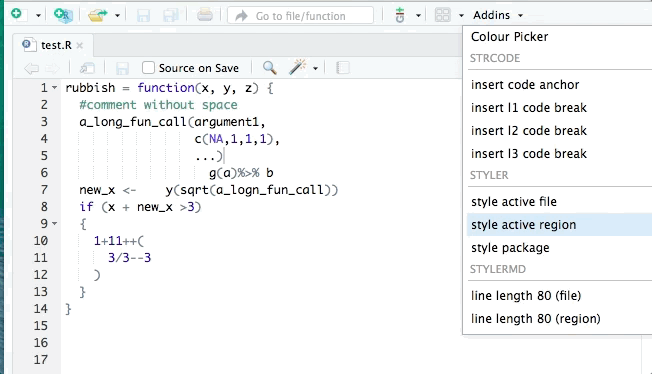

Now, you could make the body of this for loop more complex to create more advanced outputs.Ĭlick here to find more detailed explanations and advanced programming examples of for-loops in R.
How to write c code in r how to#
the values 1 to 10).Īt this point, you basically know how to write and run a for-loop in the R programming language. The RStudio console output is showing the final outputs of our for-loop (i.e. Note that we have to use the print function to visibly return values within a for-loop. x_for + 1) and prints the updated data object to the RStudio console using the print function (i.e. The body of our for-loop adds +1 to our data object (i.e. Also note that running indices can not be changed by the user within for-loops. Note that our running index i is increased by 1 within each iteration. i) and the collection of objects through which we want to iterate (i.e. The head of our for-loop defines the running index (i.e. elements in a vector or list) to which a code block should be applied.Ī for-loop consists of two parts: First, a header that specifies the collection of objects Second, a body containing a code block that is executed once per object.įirst, we have to specify a data object that we can use within the for-loop: So keep on reading!įor-loops specify a collection of objects (e.g. In the following, I’ll explain the different types of loops and illustrate the differences in R programming example codes. The following graphic is illustrating the workflow of each of the three loop-types: The R programming language generally provides three different types of loops: for-loops, while-loops, and repeat-loops. The loop executes a code block again and again until no further action is required.Įach time the code block within the loop is executed is called an iteration.ĭepending on your specific programming situation, you may need different loop-structures that execute the code blocks within the loop on the basis of different conditions. Our function f( x)= 2 x, implemented as double_me in the file doubler.c, is shown below.6) Advanced Tutorials on Loops What are Loops? Ī loop is a programming instruction that repeats until a specific condition is reached. The C function you will write is effectively a subroutine. No matter the nature of your function’s return value, it too must be handled using pointers. Thus, to write a compatible C function, all arguments must be pointers. C interface allows objects to be directly accessed in an R session’s active memory. C interface is the simplest but also the most limited way to call C from R. C function interface Of R’s native functions, the. So if you have a passing familiarity with C and an interest in R, grab a cup of coffee, pop open a terminal, and prepare to explore. In this article, I’ll share what I learned as concisely as possible. In the course of its implementation, I received advice from respected voices, each highlighting important points about the alternatives. My own lack of experience was mitigated by adopting a tremendously limited scope: the function f( x)= 2 x. Wanting to learn more about this connection between languages, I dug into the C calling paradigms of R. While I didn’t understand all of the finer points at the time, I never thought of R in the same way again. Allaire’s second point emphasized R’s roots as an interactive mechanism for calling code from compiled languages like C and Fortran (which you can also hear from S inventor John Chambers). For illustration, he used the librestats language composition analysis of Core R, which might not have been so interesting if it did not extend to R’s contributed packages.

The first explained just how much of modern R really is C and C++. Allaire shared two points to motivate his talk on Rcpp. It was during a Bay Area useR Group meeting, where presenter J.J. I only recently discovered the fundamental connection between the C and R languages.


 0 kommentar(er)
0 kommentar(er)
